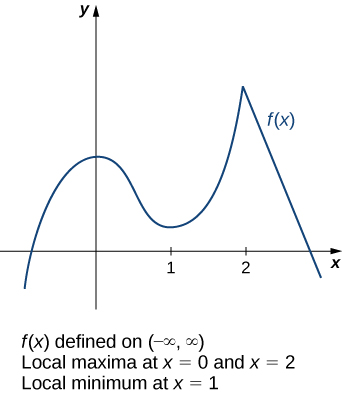Extrema and Critical Points
Local Extrema and Critical Points
Consider the function [latex]f[/latex] shown in below.

The graph can be described as two mountains with a valley in the middle. The absolute maximum value of the function occurs at the higher peak, at [latex]x=2[/latex].
However, [latex]x=0[/latex] is also a point of interest. Although [latex]f(0)[/latex] is not the largest value of [latex]f[/latex], the value [latex]f(0)[/latex] is larger than [latex]f(x)[/latex] for all [latex]x[/latex] near [latex]0[/latex]. We say [latex]f[/latex] has a local maximum at [latex]x=0[/latex].
Similarly, the function [latex]f[/latex] does not have an absolute minimum, but it does have a local minimum at [latex]x=1[/latex] because [latex]f(1)[/latex] is less than [latex]f(x)[/latex] for [latex]x[/latex] near [latex]1[/latex].
local extremum
A function [latex]f[/latex] has a local maximum at [latex]c[/latex] if there exists an open interval [latex]I[/latex] containing [latex]c[/latex] such that [latex]I[/latex] is contained in the domain of [latex]f[/latex] and [latex]f(c)\ge f(x)[/latex] for all [latex]x\in I[/latex].
A function [latex]f[/latex] has a local minimum at [latex]c[/latex] if there exists an open interval [latex]I[/latex] containing [latex]c[/latex] such that [latex]I[/latex] is contained in the domain of [latex]f[/latex] and [latex]f(c)\le f(x)[/latex] for all [latex]x\in I[/latex].
A function [latex]f[/latex] has a local extremum at [latex]c[/latex] if [latex]f[/latex] has a local maximum at [latex]c[/latex] or [latex]f[/latex] has a local minimum at [latex]c[/latex].
Note that if [latex]f[/latex] has an absolute extremum at [latex]c[/latex] and [latex]f[/latex] is defined over an interval containing [latex]c[/latex], then [latex]f(c)[/latex] is also considered a local extremum. If an absolute extremum for a function [latex]f[/latex] occurs at an endpoint, we do not consider that to be a local extremum, but instead refer to that as an endpoint extremum.
Given the graph of a function [latex]f[/latex], it is sometimes easy to see where a local maximum or local minimum occurs. However, it is not always easy to see, since the interesting features on the graph of a function may not be visible because they occur at a very small scale. Also, we may not have a graph of the function.
In these cases, how can we use a formula for a function to determine where these extrema occur?
To answer this question, let’s look at Figure 3 again.

The local extrema occur at [latex]x=0[/latex], [latex]x=1[/latex], and [latex]x=2[/latex]. Notice that at [latex]x=0[/latex] and [latex]x=1[/latex], the derivative [latex]f^{\prime}(x)=0[/latex]. At [latex]x=2[/latex], the derivative [latex]f^{\prime}(x)[/latex] does not exist, since the function [latex]f[/latex] has a corner there.
In fact, if [latex]f[/latex] has a local extremum at a point [latex]x=c[/latex], the derivative [latex]f^{\prime}(c)[/latex] must satisfy one of the following conditions: either [latex]f^{\prime}(c)=0[/latex] or [latex]f^{\prime}(c)[/latex] is undefined.
Such a value [latex]c[/latex] is known as a critical point and it is important in finding extreme values for functions.
critical point
Let [latex]c[/latex] be an interior point in the domain of [latex]f[/latex]. We say that [latex]c[/latex] is a critical point of [latex]f[/latex] if [latex]f^{\prime}(c)=0[/latex] or [latex]f^{\prime}(c)[/latex] is undefined.
As mentioned earlier, if [latex]f[/latex] has a local extremum at a point [latex]x=c[/latex], then [latex]c[/latex] must be a critical point of [latex]f[/latex]. This fact is known as Fermat’s theorem.
Fermat’s theorem
If [latex]f[/latex] has a local extremum at [latex]c[/latex] and [latex]f[/latex] is differentiable at [latex]c[/latex], then [latex]f^{\prime}(c)=0[/latex].
Proof
Suppose [latex]f[/latex] has a local extremum at [latex]c[/latex] and [latex]f[/latex] is differentiable at [latex]c[/latex]. We need to show that [latex]f^{\prime}(c)=0[/latex]. To do this, we will show that [latex]f^{\prime}(c)\ge 0[/latex] and [latex]f^{\prime}(c)\le 0[/latex], and therefore [latex]f^{\prime}(c)=0[/latex]. Since [latex]f[/latex] has a local extremum at [latex]c[/latex], [latex]f[/latex] has a local maximum or local minimum at [latex]c[/latex]. Suppose [latex]f[/latex] has a local maximum at [latex]c[/latex]. The case in which [latex]f[/latex] has a local minimum at [latex]c[/latex] can be handled similarly. There then exists an open interval [latex]I[/latex] such that [latex]f(c)\ge f(x)[/latex] for all [latex]x\in I[/latex]. Since [latex]f[/latex] is differentiable at [latex]c[/latex], from the definition of the derivative, we know that
Since this limit exists, both one-sided limits also exist and equal [latex]f^{\prime}(c)[/latex]. Therefore,
and
Since [latex]f(c)[/latex] is a local maximum, we see that [latex]f(x)-f(c)\le 0[/latex] for [latex]x[/latex] near [latex]c[/latex]. Therefore, for [latex]x[/latex] near [latex]c[/latex], but [latex]x>c[/latex], we have [latex]\frac{f(x)-f(c)}{x-c}\le 0[/latex]. From the equations above we conclude that [latex]f^{\prime}(c)\le 0[/latex]. Similarly, it can be shown that [latex]f^{\prime}(c)\ge 0[/latex]. Therefore, [latex]f^{\prime}(c)=0[/latex].
[latex]_\blacksquare[/latex]
From Fermat’s theorem, we conclude that if [latex]f[/latex] has a local extremum at [latex]c[/latex], then either [latex]f^{\prime}(c)=0[/latex] or [latex]f^{\prime}(c)[/latex] is undefined. In other words, local extrema can only occur at critical points.
Note this theorem does not claim that a function [latex]f[/latex] must have a local extremum at a critical point. Rather, it states that critical points are candidates for local extrema.
Consider the function [latex]f(x)=x^3[/latex]. We have [latex]f^{\prime}(x)=3x^2=0[/latex] when [latex]x=0[/latex]. Therefore, [latex]x=0[/latex] is a critical point. However, [latex]f(x)=x^3[/latex] is increasing over [latex](−\infty ,\infty )[/latex], and thus [latex]f[/latex] does not have a local extremum at [latex]x=0[/latex].
In Figure 4, we see several different possibilities for critical points. In some of these cases, the functions have local extrema at critical points, whereas in other cases the functions do not. Note that these graphs do not show all possibilities for the behavior of a function at a critical point.

Later in this module we look at analytical methods for determining whether a function actually has a local extremum at a critical point. For now, let’s turn our attention to finding critical points. We will use graphical observations to determine whether a critical point is associated with a local extremum.
For each of the following functions, find all critical points. Use a graphing utility to determine whether the function has a local extremum at each of the critical points.
- [latex]f(x)=\frac{1}{3}x^3-\frac{5}{2}x^2+4x[/latex]
- [latex]f(x)=(x^2-1)^3[/latex]
- [latex]f(x)=\dfrac{4x}{1+x^2}[/latex]


